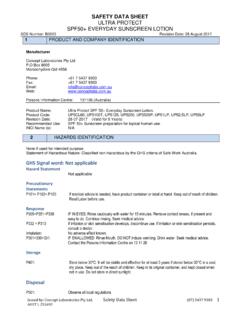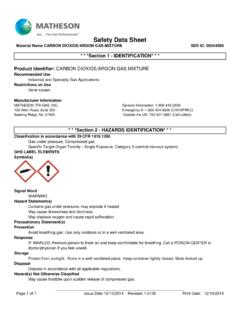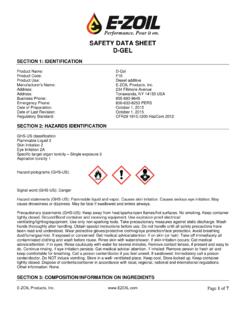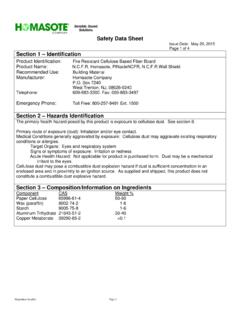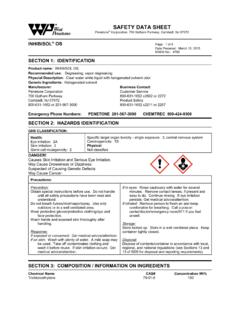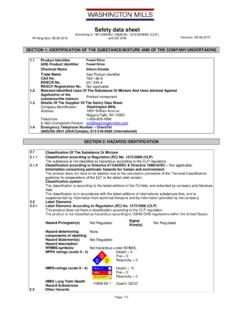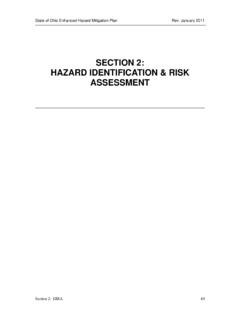Transcription of Section 2 - Hazards Identification Statement of …
1 SAFETY DATA SHEET Product Name: Air Wick Aerosol Air Freshener - Lavender Date this version issued: December, 2016 Page: 1 of 7 Section 1 - Identification of The Material and Supplier Product Name: Air Wick Aerosol Air Freshener - Lavender Product Type: Air care, instant action (aerosol sprays) SDS Number: Formulation No: #110971_11 Product Use: Consumer. Supplier Details: Australia: Reckitt Benckiser (Australia) Pty Limited ABN: 17 003 274 655 44 Wharf Road, West Ryde. NSW 2114 Tel: +61 2 9857 2000 New Zealand: Reckitt Benckiser (New Zealand) Limited 2 Fred Thomas Drive, Takapuna, Auckland, New Zealand 0622 Tel: +64 9 484 1400 Poisons Information Centre: Australia: Phone 131 126 New Zealand: 0800 764 766 or 0800 POISON Section 2 - Hazards Identification Statement of Hazardous Nature This product is classified as: F+; R12. Extremely flammable. Hazardous according to the criteria of SWA. Dangerous according to Australian Dangerous Goods (ADG) Code, IATA or IMDG/IMSBC criteria.
2 GHS Signal word: DANGER Flammable aerosols Category 1 Gases under pressure - Compressed gas HAZARD Statement : H222: Extremely flammable aerosol H280: Contains gas under pressure; may explode if heated. PREVENTION P102: Keep out of reach of children. P101: If medical advice is needed, have product container or label at hand. P251: Pressurized container: Do not pierce or burn, even after use. P210: Keep away from heat, hot surfaces, sparks, open flames and other ignition sources. No smoking. P211: Do not spray on an open flame or other ignition source. RESPONSE P305+P351+P338: IF IN EYES: Rinse cautiously with water for several minutes. Remove contact lenses, if present and easy to do. Continue rinsing. P372: Explosion risk in case of fire. P370+P378: In case of fire, use carbon dioxide, dry chemical, foam, water fog. Water fog or fine spray is the preferred medium for large fires. STORAGE P402: Store in a dry place.
3 P410+P412: Store below 30 C, protect from direct sunlight and do not expose to temperatures exceeding 50 C. DISPOSAL P501: Dispose of small quantities and empty containers by wrapping with paper and putting in garbage. For larger quantities, if recycling or reclaiming is not possible, use a commercial waste disposal service. Emergency Overview Physical Description & Colour: Colourless liquid (aerosol). SAFETY DATA SHEET Product Name: Air Wick Aerosol Air Freshener - Lavender Date this version issued: December, 2016 Page: 2 of 7 Odour: Characteristic fragrance. Major Health Hazards : None. Pressurised container: protect from sunlight and do not expose to temperature exceeding 50 C. Do not pierce or burn, even after use. Do not spray on a naked flame or any incandescent material. Keep away from sources of ignition No smoking. Keep out of the reach of children. Section 3 - Composition/Information on Ingredients Ingredients CAS No Conc, % Butane 106-97-8 10 - 15 Propane 74-98-6 - 5 Isobutane 75-28-5 - 5 Disodium tetraborate decahydrate 1303-96-4 1 Other non-hazardous ingredients secret to 100 This is a commercial product whose exact ratio of components may vary slightly.
4 Minor quantities of other non hazardous ingredients are also possible. Section 4 - First Aid Measures General Information: You should call The Poisons Information Centre if you feel that you may have been poisoned, burned or irritated by this product. The number is 13 1126 from anywhere in Australia (0800 764 766 in New Zealand) and is available at all times. Have this SDS with you when you call. Inhalation: Remove victim to fresh air and keep at rest in a position comfortable for breathing. If not breathing, if breathing is irregular or if respiratory arrest occurs, provide artificial respiration or oxygen by trained personnel. It may be dangerous to the person providing aid to give mouth-to-mouth resuscitation. Get medical attention if adverse health effects persist or are severe. If unconscious, place in recovery position and get medical attention immediately. Maintain an open airway. Skin Contact: Flush contaminated skin with plenty of water.
5 Remove contaminated clothing and shoes. Get medical attention if symptoms occur. Eye Contact: Immediately flush eyes with plenty of water, occasionally lifting the upper and lower eyelids. Check for and remove any contact lenses. Continue to rinse for at least 10 minutes. Get medical attention if irritation occurs. Ingestion: Wash out mouth with water. Remove dentures if any. Move to fresh air. If material has been swallowed and the exposed person is conscious, give small quantities of water to drink. Stop if the exposed person feels sick as vomiting may be dangerous. Do not induce vomiting unless directed to do so by medical personnel. If vomiting occurs, the head should be kept low so that vomit does not enter the lungs. Get medical attention if adverse health effects persist or are severe. Never give anything by mouth to an unconscious person. If unconscious, place in recovery position and get medical attention immediately.
6 Maintain an open airway. Protection of first-aiders: No action shall be taken involving any personal risk or without suitable training. It may be dangerous to the person providing aid to give mouth-to-mouth resuscitation. Wash contaminated clothing thoroughly with water before removing it, or wear gloves. Most important symptoms and effects, both acute and delayed Potential acute health effects Inhalation : No known significant effects or critical Hazards . Ingestion : No known significant effects or critical Hazards . Skin contact : No known significant effects or critical Hazards . Eye contact : No known significant effects or critical Hazards . Over-exposure signs/symptoms Eye contact : Adverse symptoms may include the following: irritation and redness. Skin contact : No specific data. Ingestion : No specific data. Inhalation: Adverse symptoms may include the following: respiratory tract irritation, coughing.
7 Indication of any immediate medical attention and special treatment needed Notes to physician: Treat symptomatically. SAFETY DATA SHEET Product Name: Air Wick Aerosol Air Freshener - Lavender Date this version issued: December, 2016 Page: 3 of 7 Section 5 - Fire Fighting Measures Extinguishing media Suitable extinguishing media: Use an extinguishing agent suitable for the surrounding fire. Unsuitable extinguishing media: None known Special Hazards arising from the substance or mixture Hazards from the substance or mixture: Extremely flammable aerosol. In a fire or if heated, a pressure increase will occur and the container may burst, with the risk of a subsequent explosion. Gas may accumulate in low or confined areas or travel a considerable distance to a source of ignition and flash back, causing fire or explosion. Bursting aerosol containers may be propelled from a fire at high speed. Runoff to sewer may create fire or explosion hazard.
8 Hazardous thermal decomposition products: Decomposition products may include carbon monoxide, carbon dioxide. Advice for firefighters Special protective actions for fire-fighters: Promptly isolate the scene by removing all persons from the vicinity of the incident if there is a fire. No action shall be taken involving any personal risk or without suitable training. Move containers from fire area if this can be done without risk. Use water spray to keep fire-exposed containers cool. Special protective equipment for fire-fighters: Fire-fighters should wear appropriate protective equipment and self-contained breathing apparatus (SCBA) with a full face-piece operated in positive pressure mode. Section 6 - Accidental Release Measures Personal Precautions, Protective Equipment and Emergency Procedures: For non-emergency personnel: No action shall be taken involving any personal risk or without suitable training.
9 Evacuate surrounding areas. Keep unnecessary and unprotected personnel from entering. In the case of aerosols being ruptured, care should be taken due to the rapid escape of the pressurised contents and propellant. If a large number of containers are ruptured, treat as a bulk material spillage according to the instructions in the clean-up Section . Do not touch or walk through spilt material. Shut off all ignition sources. No flares, smoking or flames in hazard area. Avoid breathing vapour or mist. Provide adequate ventilation. Wear appropriate respirator when ventilation is inadequate. Put on appropriate personal protective equipment. For emergency responders: If specialised clothing is required to deal with the spillage, take note of any information in Section 8 on suitable and unsuitable materials. See also the information in "For non-emergency personnel". Environmental Precautions: Avoid dispersal of spilt material and runoff and contact with soil, waterways, drains and sewers.
10 Inform the relevant authorities if the product has caused environmental pollution (sewers, waterways, soil or air). Methods and Material for Containment and Cleaning Up: Small spill: Stop leak if without risk. Move containers from spill area. Use spark-proof tools and explosion-proof equipment. Dilute with water and mop up if water-soluble. Alternatively, or if water-insoluble, absorb with an inert dry material and place in an appropriate waste disposal container. Dispose of via a licensed waste disposal contractor. Large spill: Stop leak if without risk. Move containers from spill area. Use spark-proof tools and explosion-proof equipment. Approach the release from upwind. Prevent entry into sewers, water courses, basements or confined areas. Wash spillages into an effluent treatment plant or proceed as follows. Contain and collect spillage with noncombustible, absorbent material sand, earth, vermiculite or diatomaceous earth and place in container for disposal according to local regulations.


